Culture of Israel
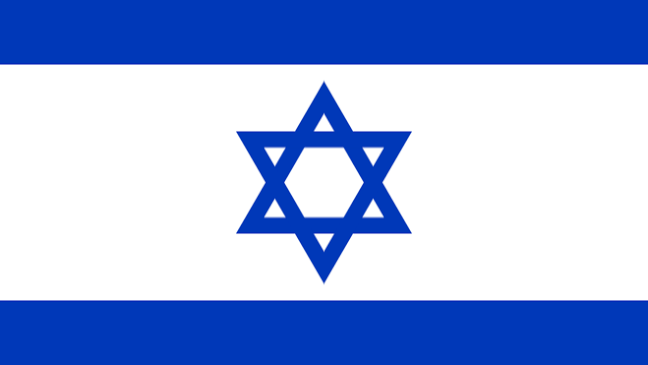
Culture Name
Israeli
Orientation
Identification. According to the Bible, Israel is the name given by God to Jacob. The modern country of Israel includes two distinct nationalities, the Palestinian and the Jewish. Each nationality is inextricable from its religious identity. The Palestinians are Arabs whose traditions are founded in Muslim culture; the Jews define their culture in large part around their religion as well. Each group identifies as part of a larger, international religious and cultural community, and each has a history in the region that goes back to ancient times.
Location and Geography. Israel is in the Middle East on the Mediterranean Sea, bordering Egypt, the Gaza Strip, Jordan, Lebanon, Syria, and the West Bank. Its total area is 8,019 square miles (20,770 square kilometers), slightly smaller than New Jersey. The Negev Desert covers the south of the country. Mountains rise in the central region from the low coastal plain along the Mediterranean. The Jordan River stretches 200 miles (322 kilometers) from Syria in the north, emptying into the Dead Sea. The Dead Sea (technically a lake) is, at 1,312 feet (400 meters) below sea level, the lowest inland sea on earth.
Demography. Israel's population in 2000 was 5,842,454. This includes an estimated 171,000 Israeli settlers in the West Bank, 20,000 in the Israeli-occupied Golan Heights, 6,500 in the Gaza Strip, and 172,000 in East Jerusalem. The population is roughly 80 percent Jewish; of the total population, 32.1 percent were born in Europe or America; 20.8 percent in Israel; 14.6 percent in Africa; and 12.6 percent in Asia. Most of the 20 percent who are not Jewish are Arab.
Linguistic Affiliation. Hebrew is the nation's official language. The modern Hebrew language was designed by Eliezer Ben-Yehuda, a Lithuanian Jew who moved to Palestine in the 1880s. Previously, biblical Hebrew had been the language of prayer, whereas the vernacular of most Jews was Yiddish (Ladino for Spanish and Portuguese Jews). David Ben-Gurion's vision of a national language, which would allow Jews from different parts of the world to communicate with each other, was an important element of the Zionist movement. Arabic is the official language of the Arab minority. English is studied in school and is the most commonly spoken foreign language. Immigrants from various countries also bring their languages with them, and Spanish, Italian, African dialects, and especially Russian are often heard.
Symbolism. The flag consists of a blue six-pointed star on a white background, with a horizontal blue stripe above and one below. The star, called a Magen David, or Shield of David, is a symbol of the Jewish faith.
The Israeli national anthem, Hatikva , is over one hundred years old. Its melody is of unknown origin, although some believe it comes from an Eastern European fold song. Its lyrics are explicitly Zionist, extolling the return of the Jews to their holy land. The song was banned from the airwaves during the British mandate, and it continues to be somewhat controversial today; there has been some debate as to whether its Zionist message is still valid.
History and Ethnic Relations
Emergence of the Nation. There is archaeological evidence of settlements in Israel dating from nine thousand to eleven thousand years ago. It is thought that the first people of the kingdom of Israel migrated from Mesopotamia. Much of the history of ancient Israel is laid out in the Bible. The Israelites were slaves in Egypt from about 1750 to
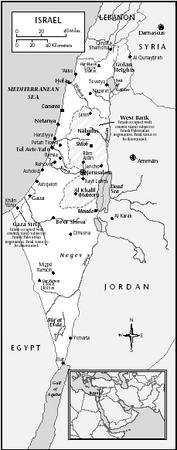
Israel
1280 B.C.E. , when Moses led the Jewish people in Exodus. They wandered in the desert for forty years. Moses died, and Joshua took the helm and led the people into the land of Canaan, or the Promised Land. The epoch that followed was known as the period of the judges, when Israel was ruled by judges and priests. Saul became the first king of Israel in 1020 B.C.E. He was succeeded by his rival, David, in 1004. Under David's rule, Jerusalem became the capital. Solomon ascended to the throne in 965 B.C.E. , and ruled for nearly forty years, during which time the First Temple was built. In 925 the kingdom split into two parts, Israel and Judah. In 721 Israel was conquered by Assyria, and in 586 it was taken over by Babylonia. The city of Jerusalem was destroyed, and the Jews were exiled to Babylon.
In 538 Babylon was conquered by the king of Persia, who allowed the Jews to return to their homeland, where they rebuilt the Temple and began what became known as the Second Jewish State. In 322 B.C.E. , Alexander the Great defeated the Persians and took control of Israel. Between 322 and 160 B.C. , the land of Israel changed hands several times under various Greek and Syrian rulers. In 160 Judas Maccabee led a rebellion that allowed the Jews to reclaim Jerusalem, a victory that Jews still celebrate in the festival of Hanukkah. Judah became an independent state in 141 B.C.E
Herod conquered Judah in 37 B.C.E. In 19 B.C.E. , under his rule, the Temple was again rebuilt. The First Revolt against Rome occurred in 66 C.E. ; however, Jerusalem fell to the Romans in 70 C.E. The Temple was destroyed, and the majority of the Jews were dispersed throughout the world.
Byzantines ruled the area from 313 to 635, although toward the end of this period, from 614 to 629, the Jews ruled Jerusalem under Persian jurisdiction. The years 622 to 632 saw the founding of Islam by Muhammad. In 638 Arab Muslims conquered Jerusalem, where their rule lasted until the Turkish conquest in 1078. The First Crusaders took the city in 1099. In 1187 Saladin, the Kurdish ruler of Egypt, conquered Jerusalem. In 1516 the land of Israel, known at this time as Palestine, was taken over by the Ottoman Turks, who ruled for four hundred years. In 1799 Napoleon unsuccessfully attempted to take the territory, but did not succeed.
The first modern Jewish settlement in Palestine was established in 1870, and was followed at the end of the nineteenth century by others, as Jews fled pogroms in Russia and Poland. In 1897 the First Zionist Conference was held in Basel, Switzerland, and under the initiative of the Hungarian Jew Theodor Herzl, the Zionist movement began its mission to create a Jewish homeland in the territory from which the Jews had been expelled nearly two thousand years earlier.
The Balfour Declaration, issued by Britain in 1917, expressed support for the establishment of a Jewish state in Palestine. The British used a 1920 mandate from the League of Nations as license to rule the area for the ensuing decades, during which time they kept control by feeding the animosity between Palestinian Arabs and Jewish settlers. The British also restricted Jewish immigration to the region, even by Jews who were experiencing persecution at the hands of the Russians, and later the Nazis. The Arabs attempted unsuccessfully to revolt against the British from 1936 to 1938; tensions between Arabs and Jews also escalated, and there were several anti-Jewish riots.
From the time Hitler came to power in 1933 until the beginning of World War II in 1939, a large number of German Jews managed to immigrate to Palestine despite British restrictions, fleeing the increasingly oppressive regime. Between 1939 and 1945 more than six million Jews were killed in the Holocaust, a horror that gave new impetus to the movement to form a Jewish state and that caused European nations to recognize the legitimacy of such a claim.
In Palestine, a truce with the British lasted through World War II, but when the war ended, violence again increased, both between Jews and Arabs and against the British. In 1947 the United Nations voted to partition Palestine into two states, one Jewish and one Arab. The Palestinians rejected this plan.
On 14 May 1948, when Israel proclaimed its independence, the declaration was met by an invasion on behalf of the Palestinians by the armies of Egypt, Jordan, Syria, Lebanon, and Iraq. The war that followed lasted until the Arab defeat in January 1949. A mass immigration of Jews from Europe and Arab countries took place over the first few years after the state's founding, and the economy grew. While some Palestinians chose to take up Israeli citizenship, many others immigrated to the primarily Arab West Bank and Gaza Strip, or sought refuge in other Arab nations.
When Egypt took control of the Suez Canal from France and Britain in 1956, Israel, fearing the increase in power of their unfriendly neighbor, staged an attack in Egypt's Sinai Desert. Several days later, Britain and France joined the offensive. The United Nations sent peacekeepers, who stayed in the region until 1967. When they pulled out, Egypt sent its military back into the Sinai, obstructing the southern Israeli port of Eilat. Israel responded by attacking on 5 June. Syria, Jordan, and Iraq came to Egypt's defense, but all four nations were defeated. The Six-Day War, as it came to be known, won Israel not just the Sinai but the Gaza Strip and the Golan Heights as well. It also resulted in a Jewish occupation of the West Bank and a reunited Jerusalem. (The city had been partitioned earlier between the Jews and the Arabs.)
The Arab League vowed that the situation would not rest and proceeded to put Israel in a state of siege. Arab terrorists highjacked Israeli airplanes. They also killed Israeli athletes at the 1972 Munich Olympics. The following year, on Yom Kippur, the holiest day of the Jewish calendar, Egypt and Syria mounted a surprise attack on Israel at the Suez and the Golan Heights. Israel managed to defeat the two armies, but the resulting situation was far from stable. In 1977 Egyptian president Anwar Sadat went to Jerusalem to talk with Israeli prime minister Menachem Begin, and in the following year U.S. president Jimmy Carter helped to broker the Camp David Accords. Sadat and Begin shared the 1978 Nobel Peace Prize for their efforts at reconciliation, and an official peace treaty was signed in 1979 in Paris.
In 1982 Israel agreed to give up the Sinai, but it also invaded Lebanon, to leave its northern settlements less vulnerable to Palestinian attacks. However, by 1985, Israel had limited its presence to a security strip along the border.
The Palestinian uprising called the Intifadah began in 1987. Palestinians threw rocks at Israeli soldiers occupying the Gaza Strip and the West Bank; the Israelis retaliated, and the violence escalated, ultimately resulting in hundreds of deaths. Israel proposed a peace initiative in 1989. This same year saw the beginning of a mass immigration by Soviet Jews.
The first peace talks between Israel and Palestinian Arabs, represented by Yasser Arafat of the Palestinian Liberation Organization (PLO), were held in Madrid in October 1991. The resulting agreement gave the Palestinians responsibility for the Gaza Strip and Jericho.
In 1993 another round of peace talks, between Israeli prime minister Yitzhak Rabin and Arafat, resulted in further compromise, including Israel handing over most of the Gaza Strip and parts of the West Bank to the Palestinian National Authority (PNA). By moving in this direction, the agreements presumed eventual statehood for the Palestinians. Other deals included resolving the issue of Israeli settlements in the West Bank and Gaza, as well as
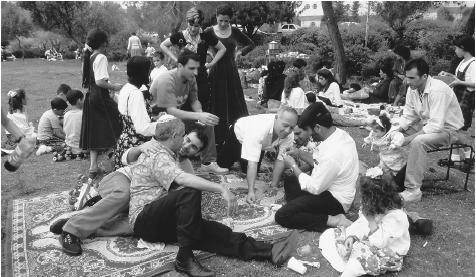
A Sephardic family celebrates the Jewish festival of Passover by sharing a picnic in West Jerusalem.
the status of Jerusalem. Arafat was to confiscate illegal arms from Palestinians, and both sides were to protect and preserve access to holy sites. These agreements, known as the Oslo Accords (after the city where the first secret rounds of talks were held), were seen as momentous steps in the peace process, and concluded at Camp David with a historic handshake between Arafat and Rabin.
Israel went on to sign a peace agreement with Jordan in 1994, and to begin talks with Syria as well. However, despite progress at the upper echelons, violence continued. In 1995 Israeli prime minister Rabin was assassinated at a peace rally in Tel Aviv. The killer was an ultraconservative Jew who was angered by what he saw as Rabin's overly conciliatory stance toward the Palestinians.
In October 1998 a conference at the Wye River in Maryland resulted in an agreement by the PLO to get rid of its terrorist groups, to confiscate illegal weapons, and to imprison their own terrorists, in exchange for more land on the West Bank. The meetings also resulted in the creation of a U.S.-Palestinian-Israeli committee, to convene several times a month to prevent terrorism and assess the state of affairs. These meetings had some degree of success, and the incremental progress appeared promising. In September 2000, violence again broke out. The fragile peace established by the Oslo Accords crumbled. By the end of November more than 280 people had been killed, most of them Palestinian, with no end to the conflict in sight.
National Identity. National identity for Israelis is to a large extent bound up with their identity as Jews. For the more devout, national identity takes on a spiritual element, in which the observance of religious ritual becomes an expression of national pride. However, there are also a large number of secular Jews in Israel, for whom Judaism is more a cultural and ethnic identity than a spiritual practice. Many Palestinians living in Israel do not identify as Israelis at all, but rather with the displaced Palestinian nation (and with the rest of the Arab world as well). Much of their national identity is also based on both religious and cultural elements of the Muslim faith.
Ethnic Relations. Relations between Jews and Arabs are extremely antagonistic. Each side sees the other as the aggressor. Palestinians resent the fact that the Jews took over their homeland, and that they have exercised their far superior military technology to maintain it, whereas the Jews feel that they are making a claim to land that is rightfully theirs, and from which they have been exiled for thousands of years. Palestinians have often resorted to terrorist action, which further aggravates the situation. Atrocities have been committed on both sides of the divide, and there is little sign of reconciliation in the near future.
Relations within the Jewish community itself also have been problematic. Many of the Orthodox and ultra-Orthodox oppose any compromise with the Palestinians and want the state to follow a more strictly religious line. They do not consider more Reform or Conservative Jews Jewish, because these more liberal branches do not strictly follow all the religious laws.
Urbanism, Architecture, and the Use of Space
Ninety percent of Israel's population is urban. Jerusalem is the capital and largest city, with a population of 602,100. It is in the center of the country, straddling the border between Israel and the West Bank. The city has been continuously settled for more than three thousand years and is home to many sites of historical and religious significance for Jews, Christians, and Muslims. These include the Dome of the Rock, the Wailing Wall, the Church of the Holy Sepulchre, and the Tomb of the Virgin Mary, among others. The Old City is divided into quarters: Jewish, Christian, Muslim, and Armenian. Outside the walls of this oldest district, the city sprawls in neighborhoods containing residential zones, parks, museums, and government buildings.
Tel Aviv is a more modern city, and the commercial and industrial capital of the country. It is in fact a combination of two cities, Tel Aviv and Jaffa. Jaffa's history dates back to biblical times, whereas Tel Aviv was founded in 1909 by European Jewish immigrants. The third-largest city in the country is Haifa, in the north. It is the country's main port and also is an industrial center.
Israel's architecture is diverse, spanning many centuries and styles. There is a good deal of Islamic architecture, most of which dates from 1250 to 1517. Today most Israelis live in modern high-rise apartments, which are overseen by committees elected by the inhabitants of the building. Some Jewish settlers in Palestinian territory, and many Palestinians themselves, live in shacks, unfinished houses, or other modest dwellings.
Food and Economy
Food in Daily Life. Falafel , ground chickpeas mixed with onions and spices formed into balls and fried, are served in pita bread as a sandwich. Other popular dishes include tabuleh (a salad of bulgar wheat and chopped vegetables), hummus (chickpea paste), grilled meats, and eggplant. Cumin, mint, garlic, onion, and black pepper are used for flavoring. Baklava is a popular dessert of Arabic origin and consists of flaky dough layered with honey and nuts. Coffee is often prepared in the Turkish style, extremely strong and thick and served in small cups.
Jews are bound by a set of dietary laws called kashrut , which, among other restrictions, forbid the consumption of pork and shellfish, as well as the consumption of both meat and milk products at the same meal. Not all Israelis observe these rules, but many restaurants do.
Food Customs at Ceremonial Occasions. Food plays an important role in nearly all Jewish celebrations. The Sabbath, observed on Saturday, is ushered in on Friday evening with a family meal including an egg bread called challah. At the Jewish New Year the challah is baked in a circle, symbolizing the cyclical nature of life. Apples and honey also are eaten, symbolizing the wish for a sweet new year. Hamentaschen are traditionally served at Purim, the celebration of Queen Esther's triumph over the evil Haman, who was trying to annihilate the Jewish people. These are cookies filled with lekvar (prune preserves) and baked in the shape of a triangle. Some believe hamentaschen symbolizes the tricornered hat of Haman; others think it is his pockets, and still others think it represents his ears, which were clipped as a sign of shame. During Passover, Jews abstain from eating all leavened foods (bread, pasta, etc.). Instead they eat matzoh ,a flat, crackerlike bread. This is in memory of the Exodus from Israel, when the Jews could not wait for their bread to rise, and so carried it on their backs to bake in the sun. Passover also is observed with a ritual meal called a seder. Four glasses of wine, representing God's four promises to Israel ("I will bring you out of Egypt;" "I will deliver you;" "I will redeem you;" and "I will take you to be my people"), are drunk throughout the evening. Other symbolic foods at the occasion include boiled eggs (symbolizing new life) and charosis (a mixture of apples and walnuts, representing the mortar the Jews used as slaves). On Shavuot in the late spring, dairy-based treats are served. Because cooking is forbidden on the Sabbath, a traditional Saturday meal is cholent , a thick stew that is left in the oven to simmer overnight.
Basic Economy. Israel's economy was originally based on a socialist model, in which the Histadrut
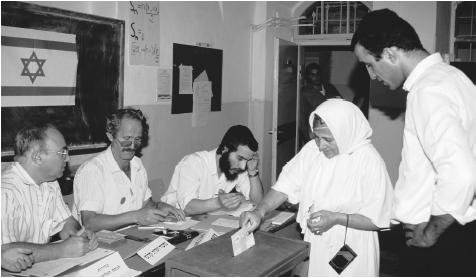
People voting in an election. Israel is a parlimentary democracy, divided into six administrative districts.
trade union was the most powerful organization, controlling most of agriculture, industry, and health care. However, in the past few decades, Histadrut's power has been diluted as the country has adopted more capitalist policies. The economy today is based largely on advanced technology. Its high-tech firms play an important role in the global economy, and foreign investment in these firms is abundant. Despite its limited natural resources, the country has become nearly self-sufficient in food production (with the exception of grains). Still, agriculture accounts for only 2 percent of the GDP and employs roughly 2 percent of the labor force. Services account for 81 percent and industry for 17 percent. The Israeli economy grew significantly during the 1990s, thanks to an influx of skilled immigrants and growth in the technology sector. While 2000 was the most financially successful year in Israel's history, gains in prosperity, and particularly foreign investments, feel somewhat tenuous after the recent outbreaks of violence.
Land Tenure and Property. Some land is privately owned and some is public property. Israel also has a system of kibbutzim (singular: kibbutz ), cooperative farms in which property is collectively owned. Residents share chores, and instead of a salary receive housing, medical care, education, and other necessities. There are also moshav , farming communities in which each family owns its own house and is responsible for its own land, but in which other functions, such as selling their products, are done collectively.
Commercial Activities. Israel produces a variety of agricultural goods, including meat and dairy products, vegetables, citrus, and other fruits. Computer industries and technology account for a large amount of the nation's commercial activity. Tourism is another important sector. Israel draws roughly two million tourists each year, with its historical and religious sites as well as resorts and health spas near the Dead Sea.
Major Industries. Israel has a variety of industries, including food processing, textiles, diamond cutting and polishing, metal products, military equipment, high-technology electronics, and tourism.
Trade. The main exports are machinery and equipment, software, cut diamonds, textiles, and agricultural products. These go primarily to the United States, the United Kingdom, Hong Kong, the Benelux countries, and Japan. Israel imports raw materials, military equipment, rough diamonds, fuel, and consumer goods from the United States, the Benelux countries, Germany, and the United Kingdom.
Division of Labor. Palestinian Israelis generally do not have access to as good an education as Israeli Jews and therefore are more likely to occupy less skilled and poorly paid positions. Immigrants as well, even highly educated ones, often are forced to take jobs of a low status, and many are unemployed.
Social Stratification
Classes and Castes. Israel is not highly stratified economically; most people have a similarly comfortable standard of living. However, the majority of the poor are Palestinian. Recent immigrants from Africa and Eastern Europe also tend to be at a disadvantage economically.
Symbols of Social Stratification. Among Israeli Jews, clothing is often an indication of religious or political affiliation. Men wear yarmulkes , or skullcaps, for prayer; more observant men wear them at all times. Conservative Jewish men can be distinguished by their black hats, whereas liberal Jews wear white crocheted caps. In the strictest Orthodox communities, men dress all in black and wear peyes , long sidelocks. Women keep their heads covered; traditionally, after marriage, they shave their heads and wear wigs. Secular or less conservative Jews, who comprise the majority of the population, wear Western-style clothes. Many Arabs wear traditional Muslim dress, which for men is a turban or other headdress and long robes, and for women is a long robe that covers the head and the entire body.
Political Life
Government. Israel is a parliamentary democracy, divided into six administrative districts. There is no formal constitution; instead, there is the Declaration of Establishment, from 1948, the Basic Laws of the parliament ( Knesset ), and the Israel citizenship law. The head of government is the prime minister, elected by popular vote for a four-year term. The 120 members of the Knesset also are elected for four years. The Knesset selects the president, who serves as chief of state.
Leadership and Political Officials. There about twelve political parties represented in the Knesset, ranging from the far right wing to the far left, and many in between. The most powerful of the conservative parties is the fairly centrist Likud . The Labor Party is the liberal party with the most clout, and the one Palestinian Israelis tend to support. The Palestinian Liberation Organization, headed by Yassar Arafat, is the main political representation of Palestinians seeking the formation of a separate state. There also are several militant and terrorist organizations with this same objective, including Hamas and Hezbollah .
Social Problems and Control. The legal system is a combination of English common law and British mandate regulations. For personal matters, Jews, Muslims, and Christians are subject to separate jurisdictions.
The role of the police force is sometimes virtually interchangeable with that the army—for example, in the case of the border guards in the West Bank. The Palestinian National Authority has its own police and security forces, which have a record of human rights abuses. Palestinian civilians have a reputation for violence against Israeli soldiers and law-enforcement officers, who in turn have a reputation for responding brutally.
Military Activity. The military consists of the Israel Defense Forces (ground, naval, and air troops), the Pioneer Fighting Youth, the Frontier Guard, and Chen (composed of women). All citizens, men and women, are required to serve in the armed forces. For unmarried women, two years of active duty are required (not in combat); for men, a minimum of four years. Military expenditures total $8.7 billion annually, 9.4 percent of the GDP.
Social Welfare and Change Programs
Social welfare programs include pensions for the elderly, maternity insurance, workers' compensation, and allowances for large families. The government also provides assistance for recent immigrants, although these programs have been criticized for helping well-off immigrants at the expense of poorer native-born Israelis.
Nongovernmental Organizations and Other Associations
A number of nongovernmental Jewish organizations make considerable economic contributions to Israel, such as the international World Zionist Organization, which supports the immigration of Jews to Israel from around the world. Synagogues in the United States and Europe also send aid and sponsor tree-planting drives. Israel also has a system of "national institutions," which are not part of the government but function alongside it in the
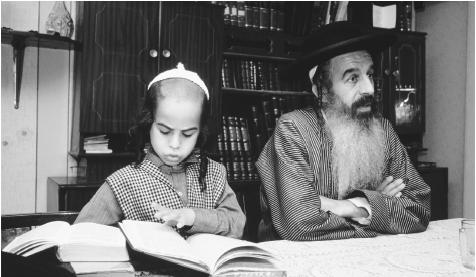
A Torah scribe works with his son. Judaism is the official Israeli religion, and the Torah is the most sacred text.
realms of social welfare services, education, and culture.
Gender Roles and Statuses
Division of Labor by Gender. Women are well represented in many fields, both traditional (teaching, nursing, child care), and nontraditional (law, politics, the military). Israel even elected a female prime minister, Golda Meir, who served from 1969 to 1974. Some strides toward equality have been reversed; while it used to be a hallmark of kibbutzim that labor was divided without respect to gender, today women are more likely to be found in the kitchen and in child care facilities. Women, like men, are required to serve in the armed forces, and during the war for independence fought in the front lines alongside men. Today women are not permitted combat. Instead they are mostly confined to adminstration and education, and usually do not achieve high-ranking positions.
The Relative Status of Women and Men. In the Orthodox tradition, women and men live very separate lives. Women are considered inferior, and are excluded from many traditional activities. However, most of Israeli society is more progressive, and women are generally accorded equal status to men, both legally and socially. (The main exception to this is the divorce law.)
Marriage, Family, and Kinship
Marriage. Traditionally, in both Arab and Jewish societies, marriages were often arranged, but that is uncommon nowadays. However, there are powerful social taboos against intermarriage, and it is illegal for a Jew to marry a non-Jew in Israel. Those wishing to do so must go abroad for the ceremony. Even within the Jewish community, it is unusual for a very observant Jew to marry someone secular. Divorce is legal, but Orthodox Jewish law applies. According to this statute, men have the power to prevent their ex-wives from remarrying. If the woman enters into another relationship, the courts refuse to recognize it, and any children from such a union are considered illegitimate and themselves cannot marry in the State of Israel.
Domestic Unit. The most common family unit consists of a nuclear family. In more traditional families, grandparents are sometimes included in this. In the original kibbutz system, the living arrangements were different. Husband and wife lived in separate quarters from their children, who were housed with the other young people. Some kibbutzim still operate in this way, but it is now more common for children to live with their parents, although their days are still spent separately.
Socialization
Infant Care. Babies are generally adored and showered with affection. The extended family plays an important role in helping to raise the baby, but the mother generally takes primary responsibility. Jewish boys are circumcised eight days after birth in a religious ceremony called a bris.
Child Rearing and Education. In most of Israeli society, children are raised in the setting of a nuclear family. However, collective child care is common, especially for mothers who work outside the home. In kibbutzim, they stay separately from their parents, and usually see them only at night or on weekends. Children are generally indulged and are not strictly disciplined.
In the Arab tradition, boys and girls are raised separately. They have different responsibilities at home, where girls are expected to help much more with domestic chores. The schools are also usually gender-segregated.
Education is mandatory from the ages five through fifteen. The state runs both religious and nonreligious schools; 70 percent of children attend the nonreligious ones. There is a separate education system for Arab children, where the language of instruction is Arabic. The quality of education in these schools is often lower due to a relative unavailability of teachers and poor resources, and they have at times been subject to closings due to violence and political instability. Arab schools receive some funding from the government, as well as from religious institutions. There are three types of high schools: academic, vocational, and agricultural.
Higher Education. Israel has seven universities. Entrance standards are high, and students must pass a national exam before being admitted. The oldest and most prestigious of these is Hebrew University in Jerusalem, which also has one of the strongest medical schools in the Middle East. Ben-Gurion University, in Beersheba, specializes in natural conservation, and Technion in Haifa focuses on science and engineering. The Weizmann Institute in Rehovot supports postgraduate study. There also are vocational, agricultural, and teacher training institutes. Yeshivot are religious academies (generally not open to women) that train future rabbis and Jewish scholars.
Etiquette
Israelis are very informal in social interactions. Their standards would, in many other countries, be considered rude. For example, store clerks do not act at all solicitous or even acknowledge a customer's presence until the customer approaches. "Please" and "thank you" are not uttered lightly. Despite this apparent brusqueness, touching and eye contact are common in social interactions.
Religious etiquette dictates that women dress conservatively when visiting holy sites (shorts are not acceptable for either gender) and that men cover their heads with a yarmulke.
Arabs are physically affectionate people, but in Arab society, men and women are often separated socially and there is less physical contact between men and women in public. It is customary to remove one's shoes before entering an Arab household.
Religion
Religious Beliefs. Judaism is the official religion. Eighty percent of the population are Jewish, 15 percent are Muslim, and 4 percent are Christian or Druze. Jews believe in the Hebrew Bible, or Tenakh, which corresponds to the Christian Old Testament. The most sacred text is the Torah, or the five books of Moses. The Bible is seen as both historical record and religious law. Different communities follow the Holy Book with varying degrees of literalness. The strictest are the ultra-Orthodox, who believe that the Scriptures were physically handed down from God. There are also Conservative, Reform, and Reconstructionist congregations, who interpret the law more leniently, and who allow women more of a role in the religion. There also are different sects of Judaism, such as the Hasidim and the Lubbavicher.
There are five pillars of faith that Muslims follow. They are: a declaration of faith in Allah; praying five times a day; giving alms to the poor; fasting from sunrise to sundown during the holy month of Ramadan; and making a pilgrimage at some point in one's life to the holy city of Mecca.
Religious Practitioners. Rabbis are the religious leaders of the Jewish community. They are ordained in Jewish law, and often are scholars in addition to delivering sermons and offering spiritual guidance. The Chief Rabbinate is a body of rabbis who make the religious laws to which Israeli Jews are subject.
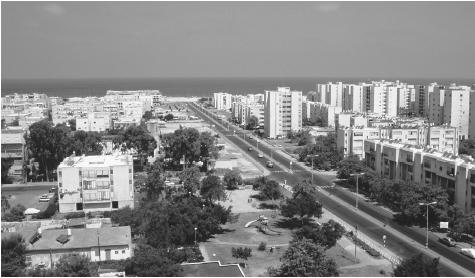
An overview of Haifa and the bay area, in 1989.
The main religious figures in the Muslim community are muezzins, who are scholars of the Koran and sound the call to prayer from mosques.
Rituals and Holy Places. Jews worship in synagogues. In the most traditional, men sit in the front and women in the back, separated by a partition, or in a balcony. There are a number of places in Israel, in Jerusalem in particular, that have religious significance to Jews, Muslims, and Christians. The Dome of the Rock is an ancient Muslim shrine. Christians often make pilgrimages to the Church of the Holy Sepulcher, also in Jerusalem. The Wailing Wall, the remains of the Temple destroyed by the Romans in 70 C.E. , is a sacred spot for Jews. There is a separate section of the wall for men and women. People often write their prayers on pieces of paper and slip them in cracks between the stones. The Jewish New Year, called Rosh Hashana, falls in September or October. Jews attend synagogue for two days and listen to readings from the Torah. The ten days following Rosh Hashana are known as the Days of Awe, a period of reflection and penitence. This culminates in Yom Kippur, the Day of Atonement, and the holiest day of the year. Jews fast from sundown to sundown and attend synagogue, where they repent for their sins and ask God to be inscribed in the Book of Life for another year. Sukkot, the harvest festival, is later in the fall. Hanukkah, which falls in December, is an eight-day holiday celebrating the victory of the Maccabees over the Greeks in C.E. 165. Purim, in the spring, celebrates Queen Esther's outsmarting Haman, who wished to kill the Jewish people. Passover, which falls later in the spring, remembers Jewish liberation from slavery in Egypt.
The bar mitzvah (for boys) or bat mitzvah (for girls) is an important coming-of-age ceremony in Judaism. Children study for years to prepare for the event that occurs when they turn thirteen. They are called to read from the Torah before the congregation; the service is followed by a party with food and dancing.
Death and the Afterlife. Judaism focuses more on the here and now, rather than the concept of an afterlife. A death is followed by a mourning period of seven days, a process called sitting shiva , during which friends and relatives pay visits to the family of the deceased and bring food. Mourners dress in black, sit on low stools, and recite prayers. Another traditional practice is for mourners to tear their clothes; today they generally rip only the lapel of their shirts. When visiting a Jewish cemetery, it is customary to place a stone on the gravestone in memory of the deceased.
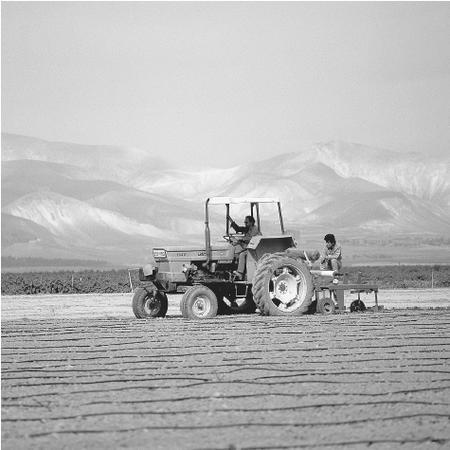
Making the desert bloom in the arid Jordan Valley, kibbutz members prepare the ground for planting winter crops.
Medicine and Health Care
Israel has a well-developed health care system. It has one of the highest ratios of doctors to general population in the world. Since independence, sanitation has improved, and the rate of infectious diseases has decreased. Histadrut, the labor federation, runs Kupat Cholim, or Sick Fund, which provides health care to members through regional hospitals and local clinics. The Ministry of Health provides for those who do not receive care from a sick fund. In general, Jews receive better health care than Arabs. The life expectancy is longer for Jews, and the infant mortality rate is significantly lower.
Secular Celebrations
Noted here are the more secular Israeli holidays, but virtually all celebrations and commemorative occasions have some religious significance. The dates of these holidays vary from year to year, because the Jewish calendar does not correspond to the Gregorian: Holocaust Memorial Day, April/May; Memorial Day, April/May; Independence Day, April/May; Jerusalem Day, May/June; National Day (Palestinian), November.
The Arts and Humanities
Support for the Arts. The government founded the magazine Ariel to promote literary endeavors. The publication now has a web page as well. There is a national drama company, Habima, as well as dance troupes, a national orchestra, and museums and galleries, including the Museum of Contemporary Art in Tel Aviv and the Israel Museum in Jerusalem.
Literature. Israel has a varied literary scene. Many of its writers have come to the country from abroad, including Zbigniew Herbert from Poland, Vasko Popa from Yugoslavia, and Robert Friend from the United States. The Israeli writer Shmuel Yosef Agnon, a German who immigrated to Israel in 1913, won the Nobel Prize for literature in 1966. The poet Arnon Levy, who was born in Jerusalem, has also gained international recognition, as has Yehuda Amichai, whose verses have been translated into a variety of languages. Amos Oz is perhaps the best-known Israeli writer internationally. Both his novels and his nonfiction have been translated into a number of languages.
Graphic Arts. Contemporary painting and sculpture are alive and well in Israel. The Israeli style is highly influenced by European art, but much of it deals explicitly with Jewish themes and issues. Israeli artists who have gained international acclaim include the painters Ya'akov Agam, Menashe Kadishman, Avigdor Arikha, and the sculptors Dany Karavan and Ygael Tumarkin.
Ritual Jewish art includes beautifully crafted menorahs (candelabra), wine cups, candlesticks, tallilot (prayer shawls), and other ceremonial objects.
Performance Arts. Israel has a well-known philharmonic orchestra. The country has produced such classical music stars as violinist Yitzhak Perlman and pianist and conductor Daniel Barenboim. The Leonard Bernstein International Music Competition in Jerusalem gives annual awards in classical music. Pop music and rock and roll also have a large following, particularly in Tel Aviv, where local stars such as Ofra Haza, Ilanit, and Shalom Hanoch perform to enthusiastic audiences. Klezmer , a form of Jewish music that originated in Eastern Europe during the seventeenth century, is a raucous blend of drums, violins, clarinets, keyboards, and tambourines that is common at wedding celebrations.
The Israel Ballet Company is world-famous. There are several modern dance troupes as well, most notably Inbal, Batsheeva, and Bat Dor. Israeli choreographer Ohad Nahrin is well known in the dance world. Israel also has a lively tradition of folk dances, which are performed by professional troupes and at occasions such as weddings. The hora , a circle dance, is one of the most commonly performed.
Theater also is popular in Israel. Jewish theater is traditionally highly melodramatic, although many contemporary productions adopt many Western theatrical conventions and social issues. There are companies that stage productions in Russian and English as well as in Hebrew and Arabic. The film industry, also thriving, is best known for its documentaries, including Yaakov Gross's Pioneers of Zion , produced in 1995, and Toward Jerusalem , Ruth Beckermann's 1992 production.
The State of the Physical and Social Sciences
The country's scientific and technological progress has been aided in recent years by an influx of well-educated immigrants from the former Soviet Union. Israeli scientists have made contributions in electronics, nuclear and solar power, and computer hardware and software, as well as in weapons-related technology. Cutting-edge firms have developed wireless and cellular telephone technology, as well as new applications for the Internet.
Bibliography
Cohen, Asher, and Susser, Bernard. Israel and the Politics of Jewish Identity: The Secular-Religious Impasse , 2000.
Doran, Gideon, and Harris, Michael. Public Policy and Electoral Reform: The Case of Israel , 2000.
Gross, David C. Israel: An Illustrated Dictionary , 2000.
Hamad, Jamil. "No Patience for a Peace Deal." Time , 13 November 2000.
——. "Arafat May Now Want to Calm the Situation." Time , 15 November 2000.
Heller, Joseph. The Birth of Israel 1945–49: Ben-Gurion and His Critics , 2000.
Herzog, Hanna. Gendering Politics: Women in Israel , 1999.
Karsh, Efraim. Israel: The First Hundred Years , 2000.
Leshem, Elazar, and Shuval, Judith T., eds. Immigration to Israel: Sociological Perspectives , 1998.
MacFarquhar, Neil. "Arafat Asks U.N. Council to Send Force to Protect Palestinians." New York Times , 11 November 2000.
Matza, Michael. "Seven Years After Oslo Pacts, Mideast Peace Is Elusive." Philadelphia Inquirer , 24 November 2000.
Morris, Nomi. "Jewish Group Helps Arabs Harvest Olives." Philadelphia Inquirer , 27 November 2000.
Orme, William A. "Fighting in Mideast Blocks Wave of Christian Tourism." New York Times , 11 November 2000.
Pappé, Ilan, ed. The Israel/Palestine Question , 1999.
Rees, Matt. "At the Speed of Hate." Time , 13 November 2000.
——. "Into the War Zones." Time , 30 November 2000.
Reich, Bernard, and Goldberg, David H. Political Dictionary of Israel , 2000.
Rejwan, Nissim. Israel in Search of Identity: Reading the Formative Years , 1999.
Said, Edward. The End of the Peace Process: Oslo and After , 2000.
Shafir, Gershon, and Peled, Yuav. New Israel: Peacemaking and Liberalization , 2000.
Wanna, Butros. "Israel Attacks South Lebanon." Philadelphia Inquirer , 27 November 2000.
Zielenziger, Michael. "Clashes in Israel Sound Across the High-Tech World." Philadephia Inquirer , 23 November 2000.
